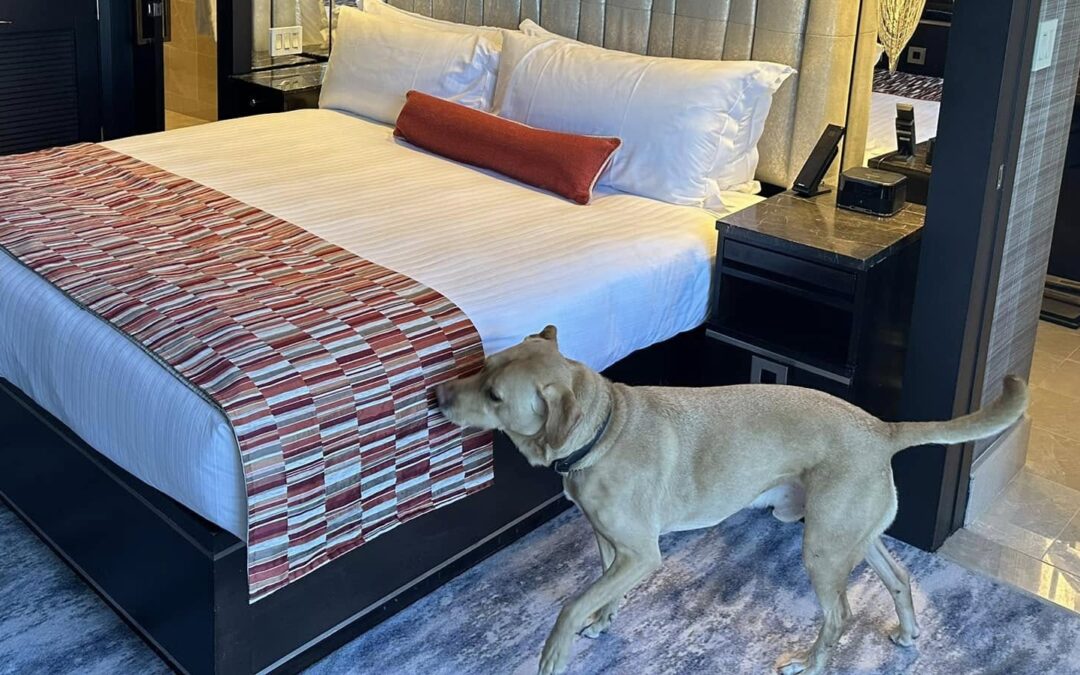Bed bugs are one of the most persistent and relentless household pests. Early detection is critical to preventing infestations from escalating. Traditional methods of detection rely heavily on visual inspections. This is not only time consuming, it is often ineffective when it comes to identifying infestations in walls, furniture and other hard-to-reach places.
Canine bed bug inspections have become a popular alternative to traditional methods of detecting bed bugs. Canine bed bug inspectors are highly efficient and expertly trained in the detection of bed bugs. These dogs have become an asset in the battle against bed bugs.
Here’s what to expect when you schedule a canine bed bug inspection:
How to Prepare
When you schedule your inspection you should expect the canine handler to provide specific instructions on how to prepare for your inspection. Every handler and every dog is unique and they may have certain guidelines they will need you to follow.
Having said that, there are some common steps that will help you prepare for your canine inspection.
- Minimize Clutter – A cluttered home makes it more difficult for the dog and its handler to work effectively. A tidy environment helps the canine team navigate through the inspection process quickly and efficiently.
- Eliminate Strong Odors – Accurate bed bug detection relies on the dog’s extraordinary sense of smell. But strong odors can interfere with the dog’s ability to detect bed bug scents. Refrain from using air fresheners, scented candles, or strong cleaning products prior to your scheduled inspection.
- Secure Your Pets – Other animals in the home may distract the detection dogs. Pets should be isolated in a separate area of the home to avoid disrupting the inspection process.
- Inform the Inspector About any Prior Treatments – Notify your dog’s handler of any previous bed bug treatments. Your inspector needs to know if any insecticides (professional or do-it-yourself) have been used in your home in order to accurately assess the environment.
Meet Your Inspection Team
A canine inspection team typically consists of a trained detection dog and a professional handler. The handler is trained in canine behavior and understands how to accurately interpret the dog’s alerts.
When the detection team arrives the handler will walk you through the steps involve in a home inspection. This is a good time to ask any questions you may have about the process. Next, the handler will make an initial visual inspection of the environment. Once the dog’s handler has the lay of the land they will prepare their canine partner and the inspection will begin.
The Inspection Process
In order for the inspection to be effective the process must be thorough and systematic. The handler will guide the dog throughout your home. They will inspect bedrooms, living rooms, dens and closets. Dogs trained for bed bug detection work quickly and in most cases an entire home can be covered in about an hour.
- Detecting Bed Bugs – Canine inspectors are trained to identify the scent of living bed bugs and viable eggs. There sense of smell is acute that they can pinpoint infestations hidden in furniture, mattresses and behind baseboards and electrical outlets.
- Alert Signals – When a dog detects the presence of bed bugs they will perform an alert signal to notify their handler. Typical alert signals include sitting, lying down or pawing at the targeted area. The handler will then inspect the area further to confirm the presence of bed bugs.
- Accuracy – Well trained detection dogs have an accuracy rate of more than 90%. Canines significantly outperform human inspectors who rely solely on visual confirmation.
After the Inspection
Once the inspection is complete the handler will provide you with a detailed report of their findings. If bed bugs are detected immediate action is recommended to prevent further spread of the infestation.
Treatment strategies typically include:
- Professional Extermination – A licensed pest control service can offer chemical treatments, heat treatments or freezing techniques to eradicate the bed bugs.
- Encasement of Mattresses and Furniture – Special bed bug-proof covers can help contain and prevent further infestations.
- Follow-Up Inspections – A follow-up inspection may be recommended after treatment to ensure the infestation has been completely eliminated.
Benefits of Canine Bed Bug Detection
Canine bed bug detection offers some very tangible benefits to homeowners facing potential bed bug infestations:
- Speed and Accuracy – Bed bug inspection dogs can inspect large areas in a fraction of the time it would take for a human inspector to make a visual inspection. Canine detection is proven to be 90% accurate.
- Non-Invasive – Traditional inspections often require you to move or dismantle furniture. Canine detection is less disruptive for your home and family.
- Early Detection – Bed bug inspection dogs can identify bed bugs at the earliest stages of an infestation. This makes treatment more effective and less expensive.
Canine bed bug inspections offer a fast, reliable, and non-invasive way to detect infestations. Whether you are confirming a suspected infestation or simply conducting a routine home inspection, a trained bed bug detection dog can provide peace of mind while helping you take the steps you need to maintain a pest-free home.
Published by Scott Palatnik
We are Bedbug Inspection & Elimination specialists.
From Manhattan to Montauk and all points in between.
Got questions?
We got answers.
Give us a call @ 516-619-6149

